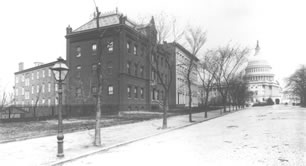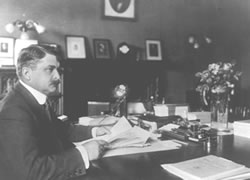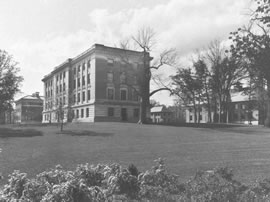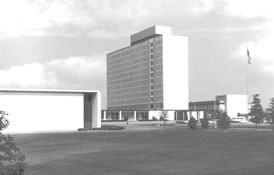
> NIST
Celebrates Centennial
>
41st IUPAC Council Meeting
> IUPAC
Prize
> Symposia Reports
> New Projects
> Provisional Recommendations
> New Books
> Commissions Reports
> Conference
Announcements
> Conference Calendar
Download the May
issue in pdf format.
(637KB)
Download the May
cover in pdf format.
(86KB)
Chemistry International
Vol. 23, No.3
May 2001
The National Institute of Standards and Technology (NIST) Celebrates its Centennial
Introduction
Establishment of the National Bureau of Standards (NBS)
Scientific Work of NBS/NIST
NBS/NIST Participation in IUPAC
Events to Mark the Centenniaby Dr. Robert N. Goldberg and Dr. David R. Lide
The National Institute of Standards and Technology (NIST) celebrates its centennial this year. NIST, formerly known as the National Bureau of Standards (NBS), was established in 1901 by the U.S. Congress to maintain custody of the national standards of measurement and to develop new ones as needed by the country’s rapidly expanding industry. NIST/NBS has grown from a relatively small laboratory with approximately 12 employees to a major research laboratory. NIST has also had a long involvement with IUPAC in many areas of chemical research.
NBS occupied the former quarters of the Office of Weights and Measures in the Coast and Geodetic Survey Building shown here in 1901. The aim of this article is to give a brief history of NIST/NBS, with some discussion of its interactions with IUPAC.
Three excellent written histories of NIST/NBS exist. They include Measures for Progress: A History of the National Bureau of Standards, by R. C. Cochrane (National Bureau of Standards, U.S. Department of Commerce, Washington, DC, 1966, 2nd Printing, 1974); A Unique Institution: The National Bureau of Standards, 1950-1969, by E. Passaglia and K. A. Beal (NIST Special Publication 925, U.S. Department of Commerce, Technology Administration, NIST, Washington, DC, for sale by the Superintendent of Documents, U.S. Government Printing Office, 1999); and Responding to National Needs: The National Bureau of Standards Becomes the National Institute of Standards and Technology, 1969-1993, by J. F. Schooley (NIST Special Publication 955. U.S. Department of Commerce, Technology Administration, NIST, Washington, DC, for sale by the Superintendent of Documents, U.S. Government Printing Office, 2000). The history described herein has been excerpted from these sources.
Establishment of the National Bureau of Standards (NBS)
Samuel Wesley Stratton, the first director of NBS. The United States was a rapidly changing nation 100 years ago. The country had been primarily agricultural for most of the 19th century, but had undergone extremely rapid industrial growth in the latter part of that century. By 1900, the United States was already a major industrial power, and electricity was arriving in many cities and towns. Articles of commerce require legally based standards to ensure fairness in trade, and there was clearly a need for standards for many physical quantities.
In 1836, the United States had established a Bureau of Weights and Measures that maintained standards of mass, length, and volume. In 1884, the Bureau of Weights and Measures also adopted standards for electrical units. Yet, the work of the Bureau of Weights and Measures had very little legal standing, as this function was left to the individual states. Also, the United States had been one of the 17 original member states of the "Convention of the Metre" (1875) that led to the founding of the International Bureau of Weights and Measures (BIPM) in Paris. By the end of the 19th century, several countries had established prominent national standards laboratories, among them the Physikalish-Technische Reichsanstalt (Germany, 1887) and the National Physical Laboratory (Great Britain, 1899). Surprisingly, at the turn of the last century, the United States was the only great commercial nation without a significant standards laboratory. Thus, a convincing case for the establishment of a proper standards laboratory could easily be made on the basis of the rapidly changing nature of the nation’s economy, a desire to aid the scientific enterprise, and a wish to be commensurate in this important activity with other modern nations in the new century. As indicated above, the need for standards was particularly acute in regard to the rapidly developing electrical industry. Thus, the administration of President McKinley pressed Congress for the establishment of a modern national standards laboratory. Enabling legislation was passed 3 March 1901, but did not become effective until 1 July 1901. The National Bureau of Standards (NBS) was originally established within the Department of the Treasury; it was moved to the newly formed Department of Commerce (and Labor) in 1904.
NBS was first located in the Coast and Geodetic Survey Building, which was the home of the Office of Weights and Measures in Washington, DC. The first director, Samuel Wesley Stratton, had been a professor of physics at the University of Chicago. He brought incredible talent and energy to the Bureau and worked hard to establish the new laboratory. The original staff consisted of approximately 12 individuals, but grew to about 800 during the nearly 22 years that he served as director before leaving in 1923 to become president of the Massachusetts Institute of Technology.
During his tenure as NBS Director, Dr. Stratton enlisted a very distinguished staff that included well-known experts in various scientific disciplines: E. B. Rosa and Frank A. Wolff (electrical measurements); Charles W. Waidner, Nathan S. Osborne, and Hobart C. Dickinson (heat and thermometry); W. W. Coblentz and W. W. Bates (optics); and W. A. Noyes and W. F. Hillebrand (chemistry). The emphasis was to serve science and industry in the nation. While the scientific work of the Bureau became ever more well-known in scientific and technical circles, the general public of-ten identified NBS with standards and calibrations. Additionally, NBS publications on subjects of interest to consumers and on popular science subjects attracted significant attention.
NBS occupied a 3-hectare site about 6km north of the White House in 1910. Subsequent land purchases expanded the site to about 28 hectares. Early in 1904, NBS moved to its Connecticut Avenue location in Washington, DC, where it would remain for about 60 years. Relocation of the main laboratory to the present Gaithersburg, Maryland site took place from 1962 to 1969. In 1951, a new NBS laboratory that specialized in cryogenics research was established in Boulder, Colorado. The Boulder laboratory also housed research on radio propagation and became the home of the Time and Frequency Division.
Most of the work of NBS/NIST had its origins in standards. Calibration services available from NBS in its early years were limited to mass, length, volume, temperature, electric potential, and resistance. Much of the early scientific equipment was imported with the assistance of the European standards laboratories. However, as NBS expanded its staff and its expertise, this relatively new laboratory rapidly became an equal to the other great standards laboratories. Because standards are almost always international in nature, collaboration with other standards laboratories and organizations has always been an important organizational goal for NBS/ NIST.
The current administration building of the National Institute of Standards and Technology at Gaithersburg, Maryland.
Scientific endeavors at NBS/NIST have resulted in two important university collaborations. The first was the Joint Institute for Laboratory Astrophysics (JILA) that was created in 1962 by a memorandum of understanding between NBS and the University of Colorado. The aim of JILA was the study of the basic physics of atoms and molecules in space. The second collaboration was the establishment with the University of Maryland in 1984 of the Center for Advanced Research in Biotechnology (CARB). The main focus of scientific research at CARB is protein chemistry. Currently, structural and theoretical chemistry, molecular biology, and thermodynamics are all applied toward understanding protein structure and function.
NBS programs were clearly affected by national and international events. Thus, NBS played an important role in the early days of government testing. These testing activities included a wide variety of products, many of which were being used by the U.S. Government. However, many of the results of the tests were made available to consumers who benefited from the information. NBS also made significant contributions to the U.S. effort during both world wars. Important breakthroughs were the development of the radio proximity fuse and improved methods for the production of synthetic rubber and aviation fuel. In 1953, the defense programs that had existed at NBS were transferred to the newly created Harry Diamond Ordnance Laboratories and the Navy Corona Laboratory, both in the Department of Defense. While this transfer involved a loss of over one-third of the NBS staff and more than one-half of its budget, it also meant that the work of NBS was now devoted primarily to standards, civilian technology, and science.
A very important change in NIST’s interaction with industry came with the Advanced Technology Program, which was established in 1988 to form a partnership with the private sector for the purpose of accelerating the development of innovative technologies that promised significant commercial payoffs and widespread benefits for the nation. An additional NIST program that interacts directly with industry is the Manufacturing Extension Partnership. It consists of a nationwide network of not-for-profit Centers in over 400 locations nationwide. Its purpose is to provide small- and medium- sized manufacturers with access to technical information that can help them succeed. NIST also manages the Malcolm Baldridge National Quality Award, which aims to encourage improvements in manufacturing performance and in the quality of goods and services. The Baldridge Award consists of a prestigious prize given annually to U.S. organizations that have demonstrated performance excellence. The increasing importance of technology in the work of NBS led to a name change. Thus, in 1988 the name of the agency was changed to "National Institute of Standards and Technology" to reflect more accurately the involvement of technology in the work that was being done.
NIST’s work is made available to the public in several forms that include calibration services, standard reference materials, standard reference data, and scientific publications as principal mechanisms for the distribution of services and information. At present, the most widely disseminated standard is time and frequency, which is broadcast from the NIST Boulder laboratory. This information, which is essential to communications and transportation, is now accessed several million times daily. The best source for current information on NIST can be found at its web site: http://www.nist.gov.
[More]
This article was contributed by Dr. Robert N. Goldberg (Biotechnology Division, NIST, Gaithersburg, MD 20899, USA; E-mail: [email protected]), Secretary of the IUPAC Commission on Biophysical Chemistry (I.7), and Dr. David R. Lide, NIST alumnus and former President of the IUPAC Physical Chemistry Division (I).
News
and Notices - Organizations and People
- Standing Committees
Divisions
- Projects - Reports
- Publications - Symposia
- AMP - Links
Page last modified 30 April 2001.
Copyright © 1997-2001 International Union of Pure and Applied Chemistry.
Questions or comments about IUPAC, please
contact the Secretariat.
Questions regarding the website, please contact [email protected]




